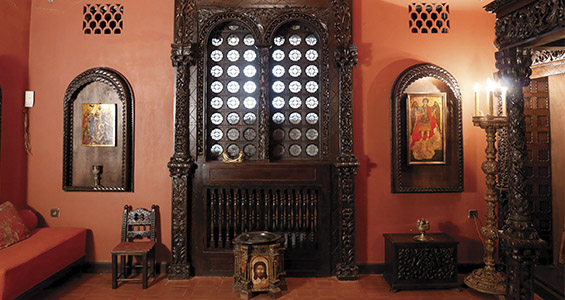The Stathatos Room

Helen Stathatos (1887-1982) was born in Alexandria, Egypt to the wealthy family of K. Konstantinidis, merchant, land owner and distinguished member of the Hellenic community of Egypt since the 1830s. In 1911 the young daughter of Konstantinidis married Antonios Stathatos, a successful businessman with connections to the Greek Royal Court, and they had two daughters. Eleni received many distinctions including that of the “Great Benefactors of the Greek Nation” due to the donation of her important collections to the Greek state. The material she collected all her life was jewelry from the Mycenaean until the post Byzantine period, a series of early byzantine oil lamps, vases and terra-cotta carvings, embroideries, Byzantine and post-byzantine icons, woodwork, Byzantine manuscripts and books. These items could be seen in the family home in Kolonaki, on 22 Herodotou street.
The relationship between Helen Stathatos and the Gennadius Library began after the Second World War. In July 1947, the then Director of the Library, Shirley H. Weber, gladly accepted the donation of three Byzantine illustrated manuscripts that he described as "the most important [gift] to the library since its dedication: the Four Gospels with portraits of the Evangelists dating back to 1226 by the protonotarios Vassilios Melitiniotis, near Caesarea (see a digital fascimile of MSS 1.5 here); a codex containing the liturgies of Ss. Basil and John Chrysostom with four full-page illuminations, copied by the monk Kallinikos (MSS 5.3); and another liturgical codex of the seventeenth century with illustrations in Armenian style, copied by the scribe Ioannis Sakoullis from Chios (MSS 5.4). The donation of these three manuscripts was considered so important that they were exhibited in a glass display case in the Reading Room (except for the summer months, when it was very hot) and were featured prominently in the documentary "Triumph over Time," produced by the American School in the same year.
Press the image for a virtual tour of the Stathatos Room
This was only the beginning of the gifts made by Helen Stathatos to the Gennadius Library. In the summer of 1952 Helen Stathatos bequeathed 35 books of art and archaeology, while other books and religious icons came to the Library between 1968 and 1972.
The librarian of the Gennadius Library Francis R. Walton contributed to the acquisition of Helen Stathatos’s most important donation: an entire period room from her home. Walton writes in the American School's Annual Report of 1968-1969: "... Mrs. Helen Stathatos offered the Gennadius Library her Macedonian living room, the smaller of the two living rooms for which her house has long been famous... The old wood carvings, with fine ornate decoration, the wonderful tiles of the fireplace, and the seven wonderful icons included along with the furnishings in the donation actually make it a museum piece. The room is to be incorporated as is in the new extension of the Gennadius Library and we will rejoice in this gift in perpetuity."
The small saloni that Eleni Stathatou donated to the Gennadius library in 1969 was the first room that she assembled herself during the 1920s. Upon learning that a church in Arta, known for its excellent woodcarvings, was about to be torn down, she acquired the carvings and arranged them in her drawing room in her mansion in Athens. The center of the room was the fireplace that showcased brightly colored blue ceramic tiles that she bought in Paris. Two large post-byzantine icons of the Virgin Mary and of Saint Andrew flanked the fireplace. Every inch of the room was full with other icons and ceramics from Asia Minor and the island of Rhodes. Four metallic lamps and two large wooden candelabra lit the room.According to the deed of gift of April 5, 1969, the American School promised to build a 5 x 5-meter room where all the pieces would be reassembled exactly as they were in the donor's house.
All items from the Macedonian Room were removed for safekeeping during the redevelopment of the Gennadius Library in 1999 and again in 2018. The room now adorns the new Makriyannis Wing of the Gennadius Library and can be visited by appointment.
